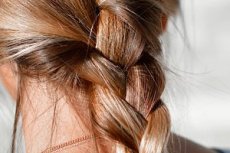Hair loss in women during pregnancy after childbirth
Last reviewed: 13.12.2018

All iLive content is medically reviewed or fact checked to ensure as much factual accuracy as possible.
We have strict sourcing guidelines and only link to reputable media sites, academic research institutions and, whenever possible, medically peer reviewed studies. Note that the numbers in parentheses ([1], [2], etc.) are clickable links to these studies.
If you feel that any of our content is inaccurate, out-of-date, or otherwise questionable, please select it and press Ctrl + Enter.

The problem that many pregnant women face is hair loss. Alopecia in the period of gestation is associated with such factors:
- Hormonal changes in the body.
- Weakening of the immune system.
- Diseases of internal organs and body systems.
- Dermatological pathologies.
- Exacerbation of chronic diseases.
- Disturbances in the thyroid gland.
- Iron deficiency anemia, lack of protein, omega-fatty acids and other substances.
- Incorrect food.
During pregnancy, vitamins that enter the body are distributed so that the hair follicles do not have enough nutrients. The problem of hair loss is particularly relevant in the second and third trimesters, since in this period there is an active development of the fetus. If a woman does not have enough vitamins, the future child takes most of the available ones, causing a weakening of the body.
The future mother is faced not only with the problem of loosening the curls, but also with the deterioration of the teeth, nails, skin. In some women, the curls are so weak that they fall out with locks, creating visible bald patches. To eliminate this cosmetic problem, use the safest possible means: physiotherapy, shampoos, masks, vitamins. The state of the hairstyle is restored within 4-6 months after childbirth.
Hair loss in women after childbirth
This is one of the most common causes of hair loss on the head in women. Many mummies note that during pregnancy, the curls become thick and silky, while in 2-3 months after delivery begins their intense loss.
The main causes of postpartum baldness include:
- Hormonal changes - a decrease in the production of estrogen after the birth of a child is a natural process. Curls begin to be updated, because of which a large number of hairs are lost daily. This process is physiological and terminates within 4-6 months.
- Stress and chronic fatigue - lack of sleep and increased physical activity negatively affect women's beauty and health as a whole.
- Unbalanced food - because of the care of the newborn, many women do not have time for adequate nutrition, interrupting with light snacks. The body does not receive a sufficient number of useful components and begins to spend its own reserves, which negatively affects the condition of the head of hear.
- Violation of blood circulation - because of problems with the cardiovascular system, hair follicles do not receive a sufficient number of useful components, begin to weaken and die. Because of this, there is an abundant loss of strands.
- Iron deficiency in the body - anemia after pregnancy and a decreased level of hemoglobin can occur due to the large blood loss during childbirth.
- Anesthesia - if the birth was not natural, but with the help of cesarean section, the woman was anesthetized. The effect of the medicines used adversely affects the state of vegetation.
Regardless of the cause of baldness, the first signs of alopecia should be addressed to a trichologist or dermatologist. Owners of long hairstyles are recommended to make a haircut in order to reduce the load on the follicles.
In the diet should include foods rich in iron, iodine, zinc, calcium, magnesium and other nutrients, adhere to proper nutrition. It is not recommended to dry strands with the use of a hair dryer, stain them until full recovery or do chemical perm. Regular head massages intensify the blood flow, which favorably affects the growth of the follicles and the condition of the head of hear.

